It seems we can’t find what you’re looking for. Perhaps searching can help.
Sign Up for newsletter!
Subscribe to get the latest eBook!
Hotline






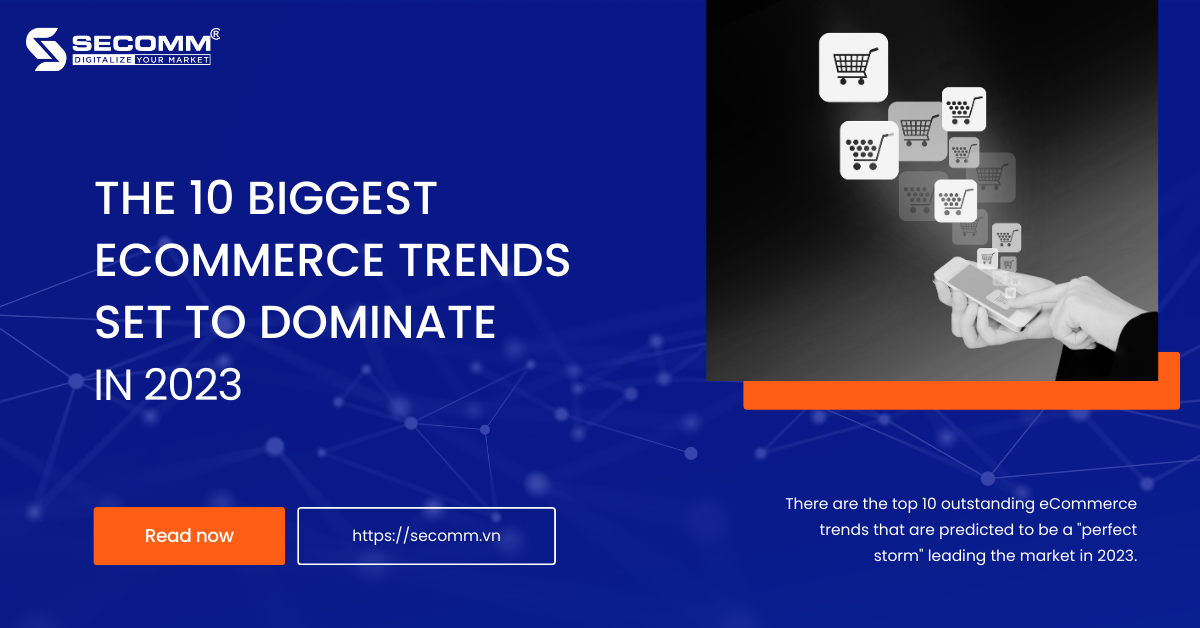
The eCommerce industry has a sizable market share in the Vietnamese economy and has shown impressive growth over the past two years due to the effects of the worldwide pandemic and social isolation.
After a year of society adjusting to the “new normal”, customers have started to buy at traditional stores again but the established trend of eCommerce consumption and the push from the wave of global digital transformation have encouraged businesses to change in order to suit the way the digital economy works.
Therefore, recognizing and anticipating the eCommerce trend of 2023 is extremely necessary for businesses’ New Year’s Marketing strategies to be implemented effectively and successfully.
Below is a list of 10 eCommerce trends that are forecast to “storm” the market in the next year.
Omnichannel is an omnichannel sales model that helps businesses reach customers through many channels such as eCommerce websites, social networks, eCommerce platforms, chain stores, and distribution agents but operating in just one management system.
Additionally, there is a second type of sales model called “Multi-channel” that differs from Omnichannel in that it allows for discrete marketing content, unlinked data, and independent channel operation.
When purchasing across numerous channels, continuous and seamless updates result in a heterogeneous and seamless customer experience.

Due to the lifting of social distance restrictions, consumers are beginning to return to in-store buying after two years of online shopping.
However, that doesn’t mean that eCommerce’s growth momentum is stagnant; on the contrary, it keeps exploding.
Businesses there make use of the current rise in popularity of online shopping to encourage the use of Omnichannel to improve the varied and efficient shopping experience.
As researchers have noted:
As a result, 2023 will still be recognized as a strong year for omnichannel in eCommerce.
Mobile Commerce or mCommerce is a business model that allows companies and individuals to deliver goods and services directly to consumers through handheld wireless devices such as smartphones and tablets.
According to Bankmycell, the number of smartphone users worldwide in 2022 is 6.648 billion, equivalent to 83.07% of the world population owning a smartphone.
Moreover, it is predicted that this number will increase to 7,516 billion by 2026. In addition, the percentage of global users participating in online shopping in 2022 accounts for 58.4%.
In Vietnam alone, interesting figures are listed in the Vietnam eCommerce White Book in 2022:
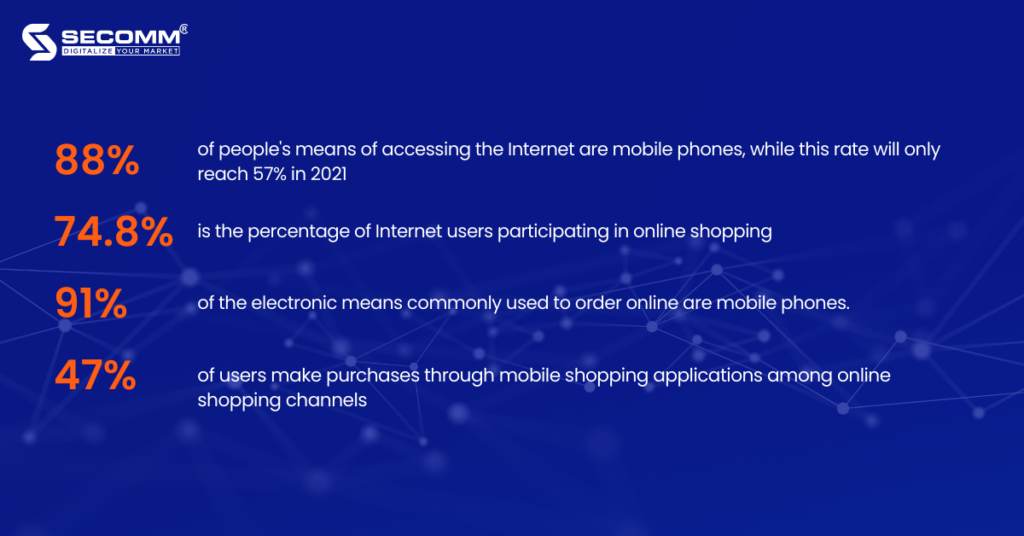
In upcoming years, the percentage of global people and Vietnamese people as well who own mobile devices and use them for online shopping is high and predicted to increase significantly.
Social commerce refers to the method through which companies advertise and sell goods and services online using social networking sites like Facebook, Instagram, TikTok, Youtube, Zalo, etc. In other words, this type of business combines eCommerce and social media.
The impact of social networks has grown significantly in recent years. Over 59% of the world’s population uses social media, it is not surprising that this percentage will continue to rise.
While in the past businesses used social media to raise brand awareness and draw in new customers, today eCommerce businesses boost sales by offering goods and services to clients online via social media.
As a result, it’s incredibly handy for customers to interact, exchange information, and search and shop online all in one location.
According to Statista, global social commerce sales will reach $992 billion in 2022 and are projected to reach nearly $3 trillion by 2026.
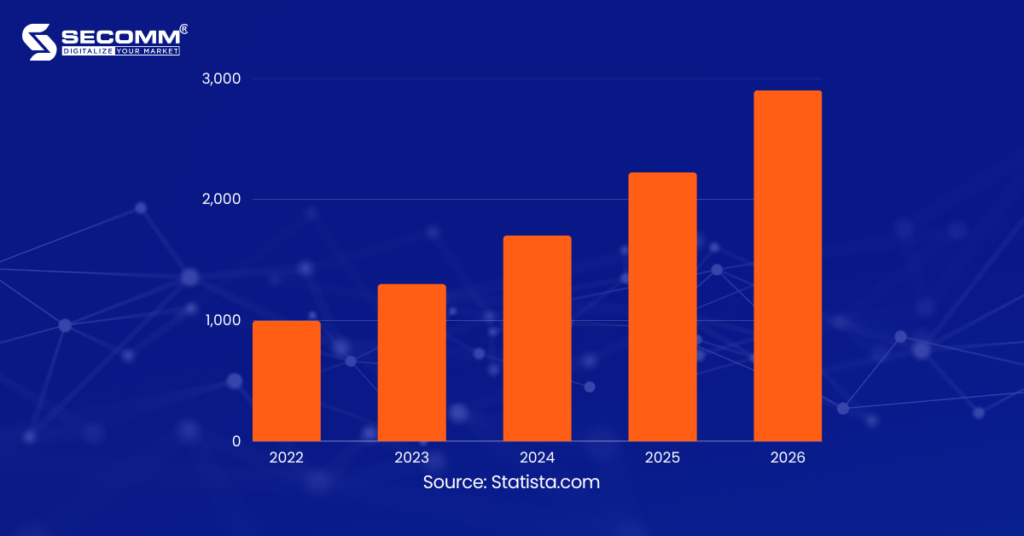
Thanks to the development of social networks, social commerce has had a strong acceleration and has become a magnet for brands to come to approach and analyze a large number of potential customers, and achieve marketing and sales goals.
As a result, failing to prioritize social commerce in enterprises’ marketing strategies in 2023 is probably to lead to a significant loss of competitive advantages in the eCommerce market.
Today, businesses have a lot of choices to build an eCommerce website, but basically, the structure of a website will include the following main parts:
For websites using a traditional structure, the frontend and backend will be operated on the same platform and from there will be closely connected with each other. Therefore, any changes on the website will be edited in two parts at the same time. However, with Headless Commerce, the backend and frontend will be decoupled from each other and operate independently on two separate systems.
The benefits of deploying Headless Commerce:
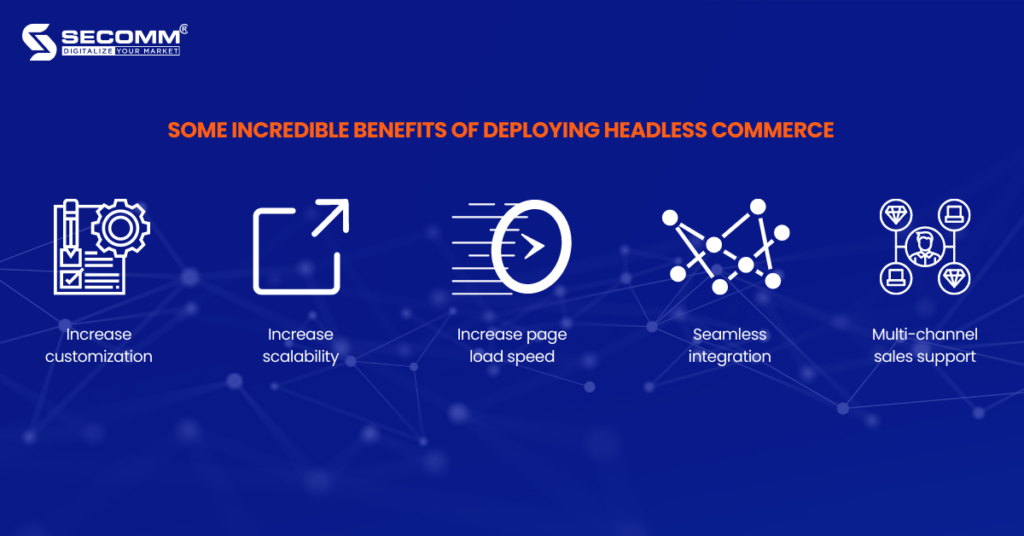
By using the Headless structure, Nike has become a brand with a much larger market share than Adidas – a formidable competitor of Nike.
Moreover, Nike’s website recorded more than 60 million pageviews in just 1 month. In addition, the proportion of direct purchases without intermediaries also increased significantly.
From Nike’s Case Study, one of the practical alternatives for companies looking to encourage eCommerce sales growth is Headless Commerce.
Shoppertainment is a form of shopping combined with entertainment that is used as a marketing strategy to encourage customer engagement with brands and consequently increase shopping demand. Moreover, it is used and takes over most of the online commerce in the era of digital transformation, when eCommerce is positioned at the forefront of contemporary business trends.
Some common practices of Shoppertainment trends:
These three practices all focus on entertainment and interaction. Then, the emotional element is aroused, leading to a series of unwise and unplanned shopping decisions. From a business perspective, this is beneficial for brands. TikTok‘s recent research proves it:
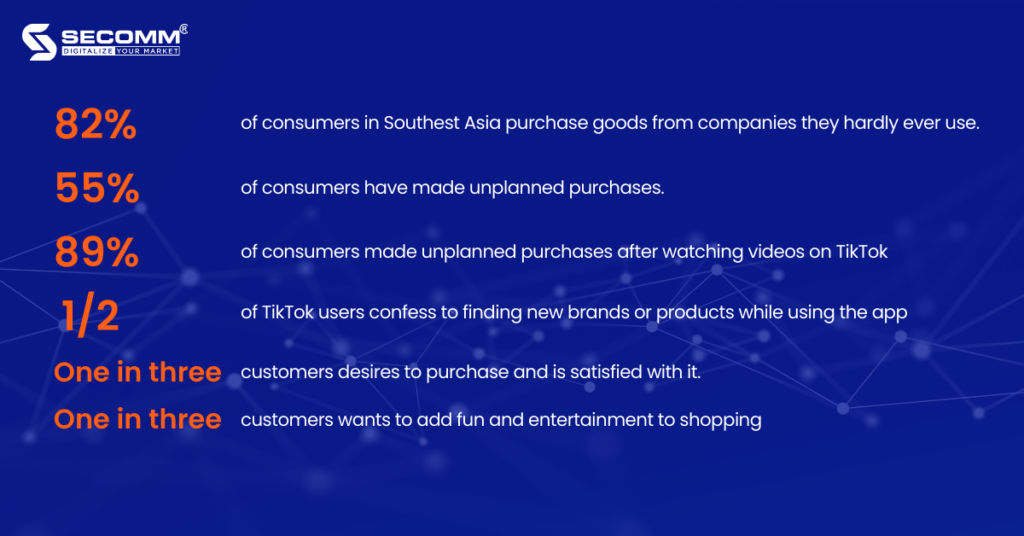
The growth of the Shoppertainment trend in recent years demonstrates the extreme demand for social interaction and connection following the period of Covid’s life.
Shoppertainment is the solution that businesses seek. This is a way to make the most of the customer’s biggest weakness – emotions.
When feelings of euphoria and joy are elicited during the shopping process, customers engage more, and purchase more unplanned products, conversion rates are higher, and sales follow.
Artificial intelligence now has a significant impact on eCommerce businesses in providing solutions to optimize the online shopping experience of customers.
The following statistics demonstrate the incredible influence of AI on the eCommerce market and businesses operating in this field:
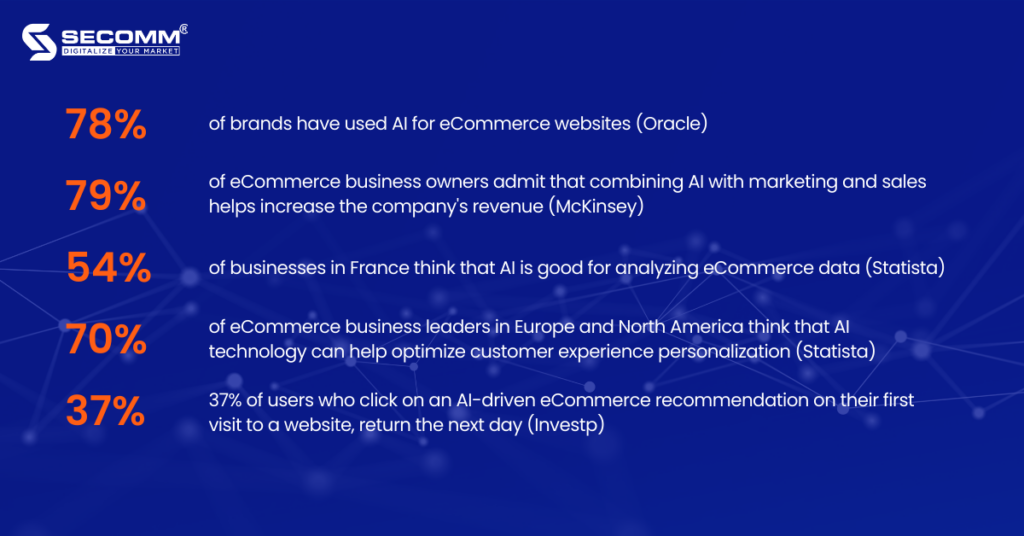
Currently, there are two applications of AI technology that are commonly used in eCommerce:
For eCommerce businesses, Chatbots will be like salespeople who can interact directly with customers 24/7. This helps businesses narrow the distance in terms of geography and time zones, helping the sales and customer services process to take place effectively without interruption.
By collecting customer data, AI can create tailored content and recommendations for each specific customer. To improve marketing campaigns and personalize the customer experience, AI can also predict purchasing behavior based on a user’s browsing and search history, when the data is legally available.
VR (Virtual Reality) is a modern technology that brings users into a simulated but still very realistic space with only 3D glasses (virtual reality glasses). The virtual world that the user sees is actually set up and controlled by a highly configurable computer system.
AR (Augmented Reality) is a new technology enhanced from VR technology. This technology has the potential to erase the boundary between the real world and the virtual 3D model. That is, users will experience virtual models in real space through smartphones or computers.
With a clear plan and the appropriate approach, Lazada has been in front of the augmented reality trend for a number of years and developed a certain competitive advantage in luring both consumers and sellers.
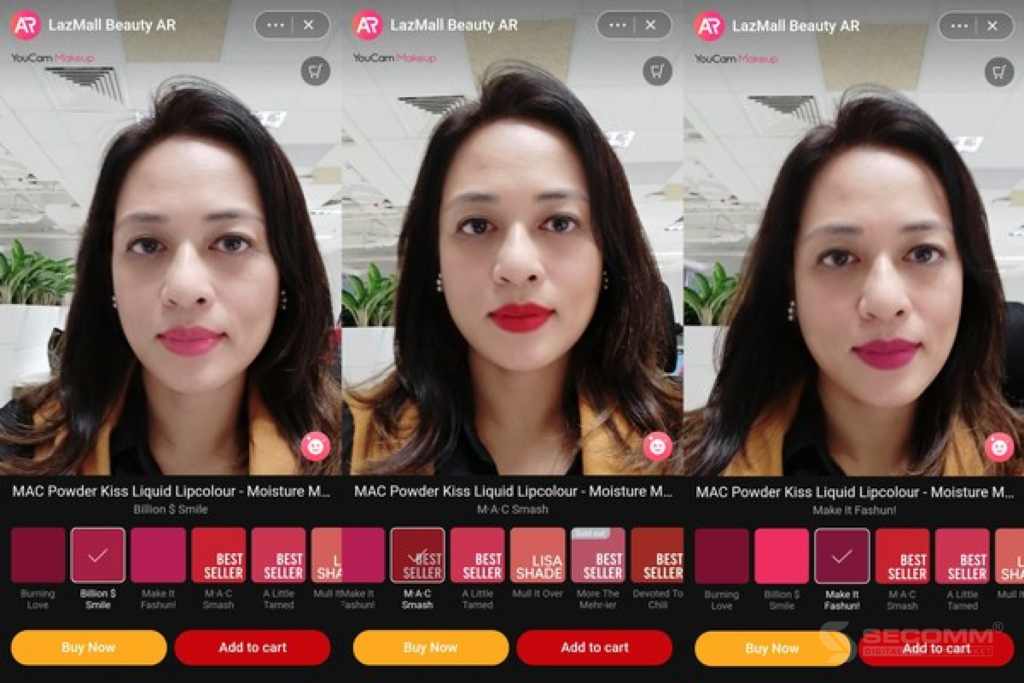
In particular, the VTO (Virtual Try On) function on Lazada includes a wealth of features to assist customers in freely selecting and trying goods like eyeshadow, eyeliner, foundation, and cushions whenever and wherever they like.
Since its launch, LazMall brand partners in the cosmetics sector have experienced tremendous success with the VTO function, which has helped to boost conversion rates by 3.1x and average order values by up to 11%.
The rapid growth of social networks and eCommerce has given marketing efforts a fresh and original breeze thanks to KOL/KOC. Although KOL and KOC have long existed in some form, they have truly taken off in recent years.
KOL – Key opinion leader, also known as an “influencer”, is an individual or organization with expert product knowledge and influence in their field or industry.
KOC – Key Opinion Consumers are “the most influential consumers in the market”. Their job is to test products and services and make comments and reviews.
KOL will suit mid- to high-end brands, while KOC will suit mid-range brands. If KOL is used to select brand ambassadors, holiday season ambassadors, or product launch campaigns, KOC is used to boost sales in a short time or direct customers to websites or eCommerce platforms.
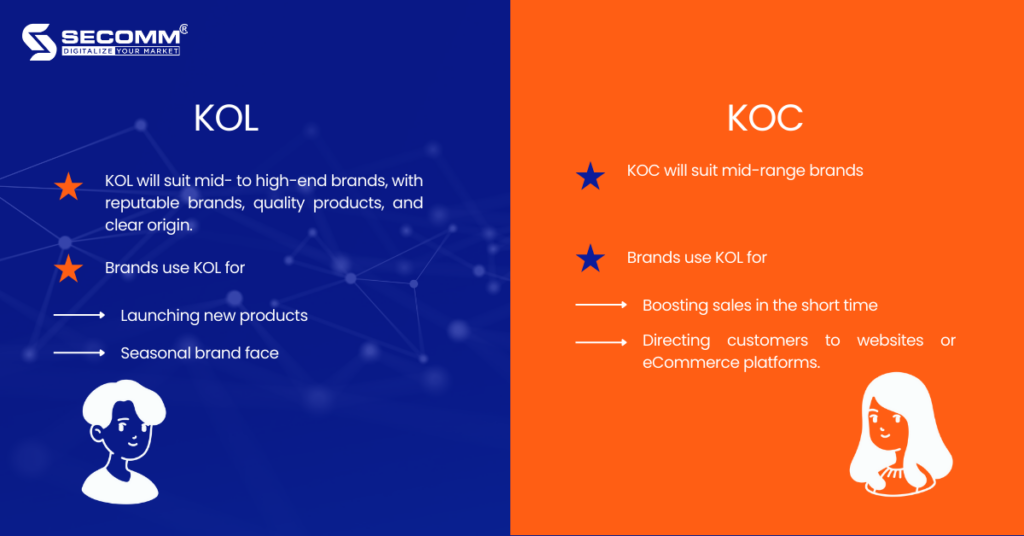
Some famous KOLs in Vietnam: Helly Tong, Giang Oi, Dino Vu, Co em Trendy, Chau Bui, Khanh Vy, Khoai Lang Thang,…
Some famous KOCs in Vietnam: Ha Linh, Call Me Duy, 1m88, Ong Giao Review, Chau Muoi, Hoang Viet, Pu Met 7,…
BOPIS – Buy Online Pick-up In Store is one of the shopping trends that promise to explode in 2023. Customers won’t have to be concerned about shipping costs, extended delivery times, or the risk of receiving unexpected goods when using BOPIS.
Businesses all around the world are pushing up their BOPIS implementation to meet customer expectations when merging online buying with in-person pickup. This is the ideal approach to boost store visits and close the gap between the offline and online buying experiences.
According to GlobeNewswire, the global BOPIS market is projected to reach $703 billion by 2027 with an estimated CARG of 19.3% between 2021-2027.
In addition, the following BOPIS trend statistics can help businesses consider implementing in 2023:
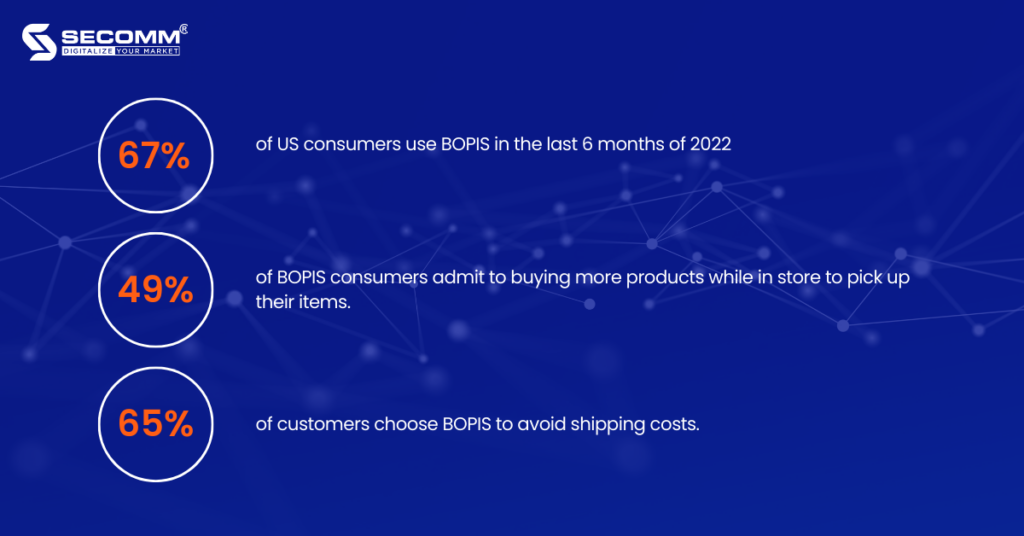
The BOPIS model also aids businesses in cutting expenses, expediting deliveries, boosting demand for retail goods, and lowering the risk of product returns.
User Generated Content, also known as UGC, includes text, photos, video and reviews. Because people are becoming less and less engaged in the brand’s message over the past ten years, UGC has grown in importance.
According to a recent Salesforce survey, 53% of Millennials think user-generated content (UGC) influences their shopping decisions, and 92% of consumers prefer content created by friends and family over that created by brands. The reason for the above numbers is trust.
Therefore, user-generated content (UGC), such as photos, videos, and customer evaluations, is trustworthy social proof and aids in the development of a company’s reputation.
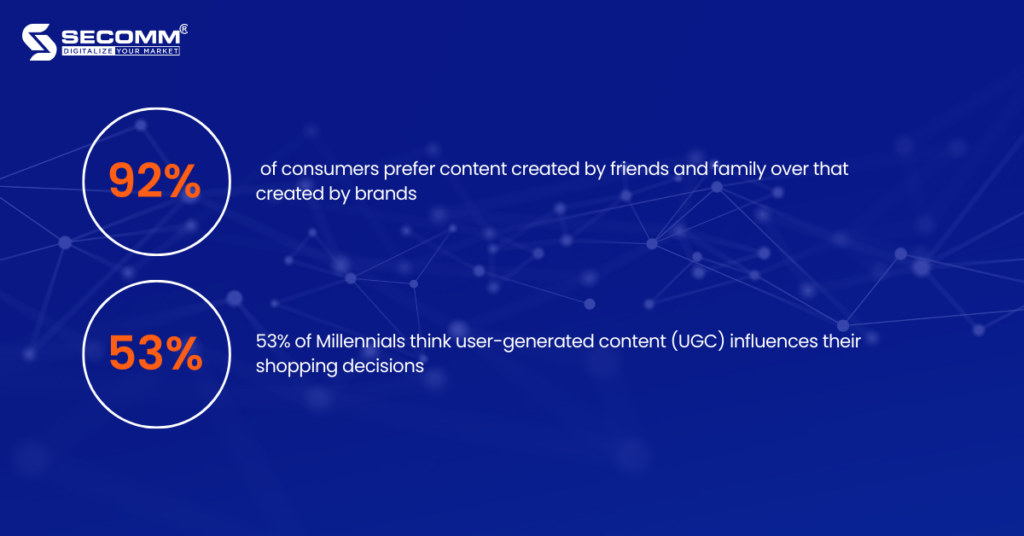
In a nutshell, businesses must quickly adapt to evolving eCommerce and digital technology trends in order to avoid falling behind and being driven out of the market. By reading 10 eCommerce trends that stated and analyzed above, businesses will have an overview to be ready for the new journey.
With many years of experience in successfully implementing eCommerce for many customers in many countries, SECOMM specializes in providing consulting services with comprehensive and professional eCommerce implementation solutions.
Contact SECOMM today for free support and advice.
 2
2
 5,400
5,400
 0
0
 1
1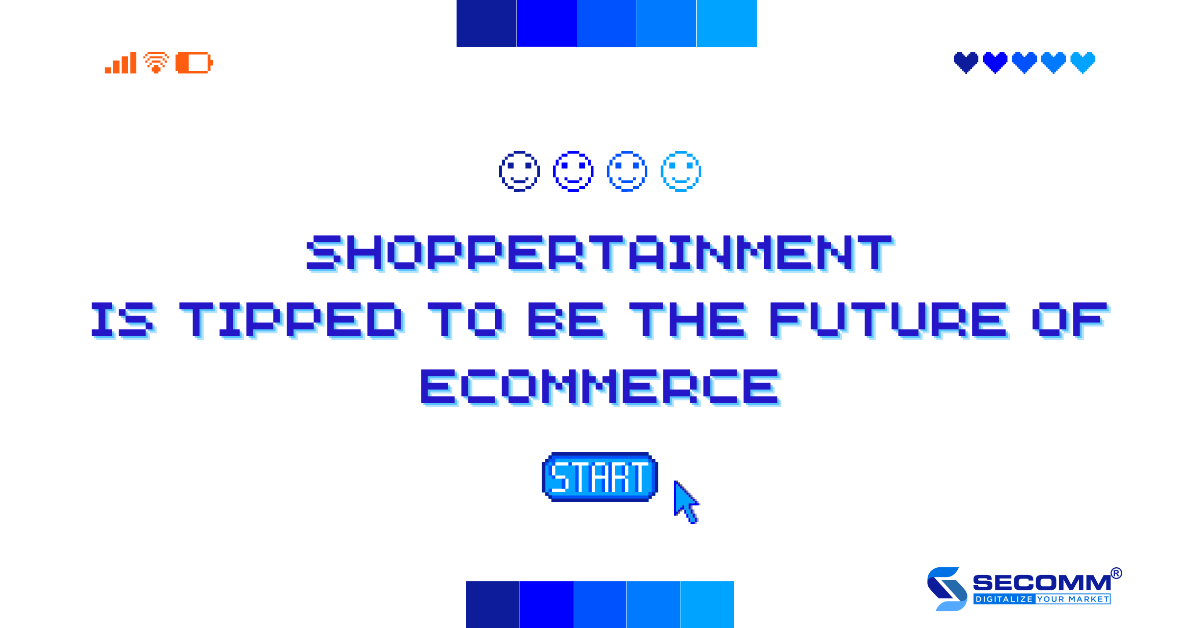
The Covid-19 pandemic not only encourages the tremendous growth of eCommerce but also helps shift consumers’ priorities from in-store to online buying. However, instead of just buying, consumers frequently prefer to seek out novel, inspiring experiences.
Therefore, every company should strive to implement the approach of shopping combined with entertainment (Shoppertainment) in order to improve marketing effectiveness and boost sales.
Shoppertainment is a combination of two elements “shopper/shopping” and “entertainment”.
Shoppertainment is described as “the provision of recreational or leisure facilities within or next to a retail store or shopping center, as part of a marketing strategy, which is designed to attract customers and stimulate purchasing” in the Oxford Dictionary (1990).
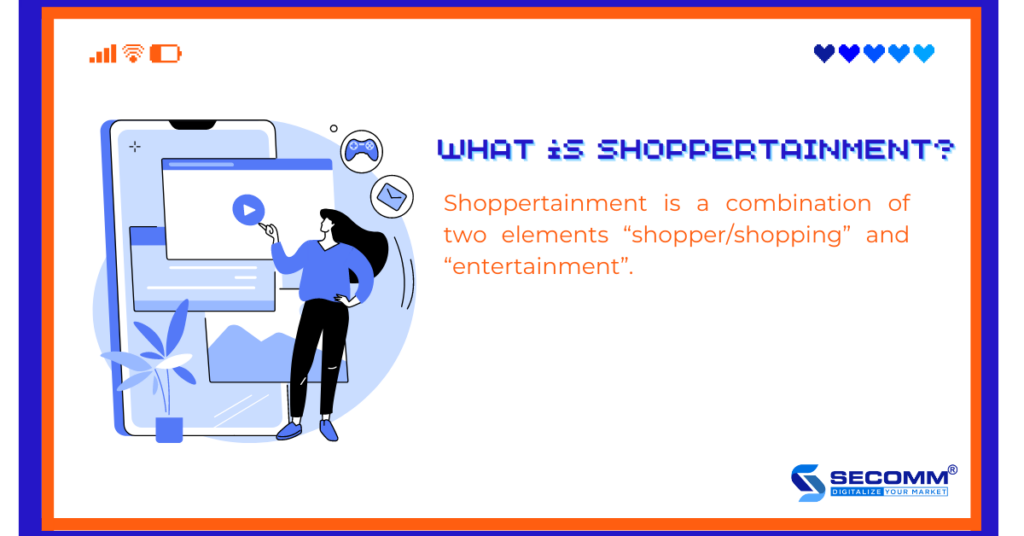
Many companies, notably IKEA, the biggest furniture retailer in the world, have used shoppertainment with success in the past. IKEA launched a campaign in 2019 called “IKEA nightclub – Tonight is to sleep” for 100 lucky individuals.
During this campaign, customers can partake in activities like manicures, massages, snacks, and tea instead of cocktails before spending the night in rooms with IKEA furniture that is soon to be released.
The brand has had remarkable sales success thanks to the campaign’s resonance in North America.
The shoppertainment trend, however, is no longer just restricted to stores or other physical locations thanks to the growth of eCommerce and digital marketing but has instead gained popularity and taken over online shopping activities.
In comparison to the prior definition, shoppertainment has been enlarged and changed. Shoppertainment is a trend that combines online shopping with entertainment, allowing buyers to engage with merchants in addition to purchasing products as usual.
In Vietnam and in the Asia-Pacific region, certain forms of entertainment-infused shopping are very common. Examples include live streaming, shoppable videos, and gamification.
According to the Vietnam eCommerce White Paper 2022, the size of the retail eCommerce market in Vietnam will increase from $11.8 billion in 2020 to $13.7 billion in 2021 and is estimated to reach 16.4 billion USD in 2022.
Meanwhile, the percentage of consumers shopping online on eCommerce websites is 78% in 2021, up 4% over the same period last year.
Because of the urgency, lack of options, and social isolation, the effects of the epidemic have actually contributed to a change in consumption tendencies from in-person purchases to online purchases.
Since that time, it has seen the quick decline of the conventional commerce model and the rise of eCommerce. By 2026, Statista projects that eCommerce sales will total $8.1 trillion.
Additionally, it is not surprising that consumers like shoppertainment. Although this combination is not novel, it promises to set the consumption trend in the years to come as eCommerce takes center stage.
The demand for online shopping will be higher there, and expectations for the best shopping experience—including both online shopping and fascinating experiences will also be higher.
Retail businesses around the world have seen a significant rise in sales during the outbreak by combining online shopping with live streams, entertainment videos, and video games to create real-time digital interactions with customers.
For instance, Taobao Live, which Alibaba introduced in 2016, saw a 150% surge in sales in 2020 when the epidemic first appeared in China.
“Shoppertainment is now a basic expectation. You really have to leverage engaging tools so the shopper gets to learn about the product, its superiority, and has fun along the way,” notes Alex Vogler, senior director and head of marketing, eBusiness, Procter & Gamble (P&G) Asia, Middle East, and Africa.
The Covid-19 pandemic has had a significant negative impact on the human psyche, causing issues including depression and anxiety. On the other hand, a portion of the populace said that the social connections they were unable to have prior to the epidemic significantly improved their psychological well-being.
People need to connect with the community and others like them more than just for amusement. Brands have therefore concentrated on improving the consumer experience by transforming personal experiences into shared ones that bring communities together.
As an example, consider the hashtag #TikTokMadeMeBuyIt. Through the TikTok platform, users can easily and amusingly share their shopping experiences, resulting in videos going viral and receiving more than 4.5 billion views.
Shoppertainment will result in emotional and impulsive purchasing decisions since it emphasizes entertainment and connection. According to a recent TikTok research:
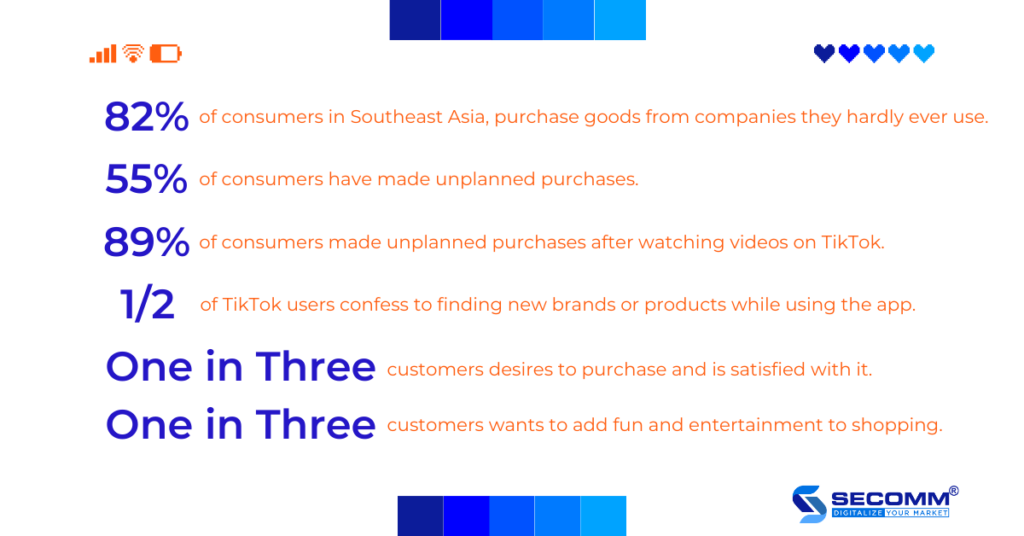
The studies mentioned above demonstrated the enormous influence that social networks and online shopping trends have on consumer decisions.
Because of this, Vietnamese retail companies have prioritized shoppertainment in their marketing plans.
Customers demand a more social and engaging online shopping experience, as well as the ability to connect and converse with one another while buying, which is the reason for any of this.
In recent years, both buyers and sellers in the Asia-Pacific (APAC) area have grown accustomed to live selling. Live selling is less common in the US and Europe than it is in APAC, but businesses there are nonetheless keeping an eye on this trend.
For instance, AliExpress initially introduced the live selling feature in France in May 2020, and since then, more than 3,000 live programs have been launched, with the involvement of more than 100 vendors.
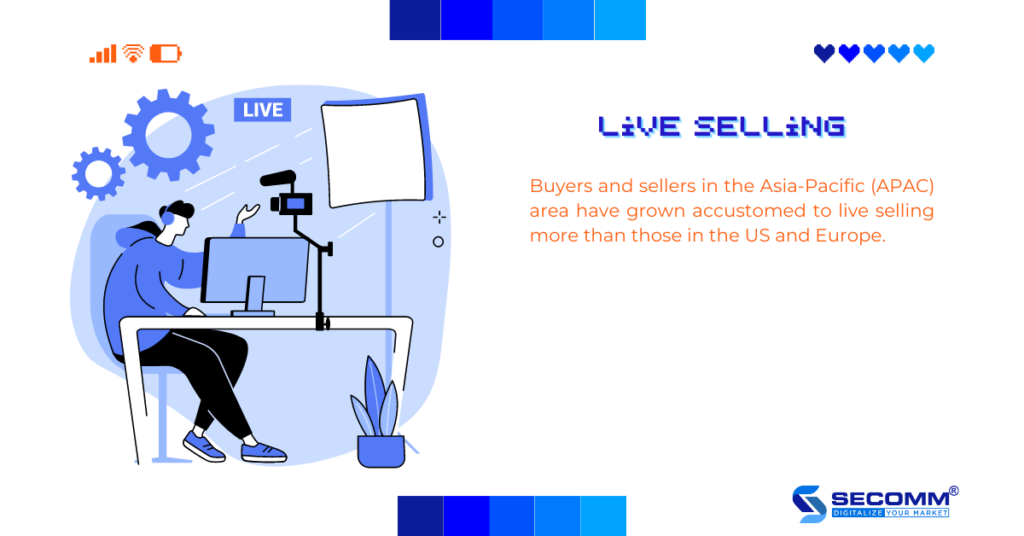
The combination of sales, interaction, and entertainment makes this one of the top social selling strategies. Customers can interact with vendors directly, view actual product photos, and make decisions by pushing their shopping emotions.
Plus, the engaging social interactions that take place throughout live streaming help retailers make an impact on customers, resulting in a high return rate.
Due to the growth of the Shoppertainment trend and the effectiveness of live streaming in generating sales through social networks, eCommerce marketplaces have started to put more of an emphasis on investing in producing engaging entertainment material for users on their apps, particularly through live streaming.
The customer buying experience is improved by several well-known live stream channels, like TaobaoLive, LazLive, Shopee Live, TikiLive, etc.
These companies have the resources to develop this feature for themselves, but lower-budgeted companies can still try the live-selling concept by integrating Facebook or YouTube live stream with an eCommerce website.
Live-streaming videos will be effectively replaced by shoppable videos. One of the joys of using this type of video is that companies may produce videos in their own distinctive styles that quickly introduce customers to their products, explain how they operate, and demonstrate how to use them. These videos can be attached to an eCommerce website. Users can always click the product link in this kind of short video to find out extra details or to make a purchase. The short-form video has overtaken popular platforms like TikTok, Instagram Reels, and Youtube Shorts as the go-to method for branding, cultivating customer trust, and influencing purchasing decisions.
83% of people, according to Nielsen study, prefer watching videos of advertisements to GIFs or text. Short-form videos have gained popularity as a result of global digital transformation and consumer preference, and many brands now opt to use those as part of their video marketing strategies due to their useful advantages, which include the following:
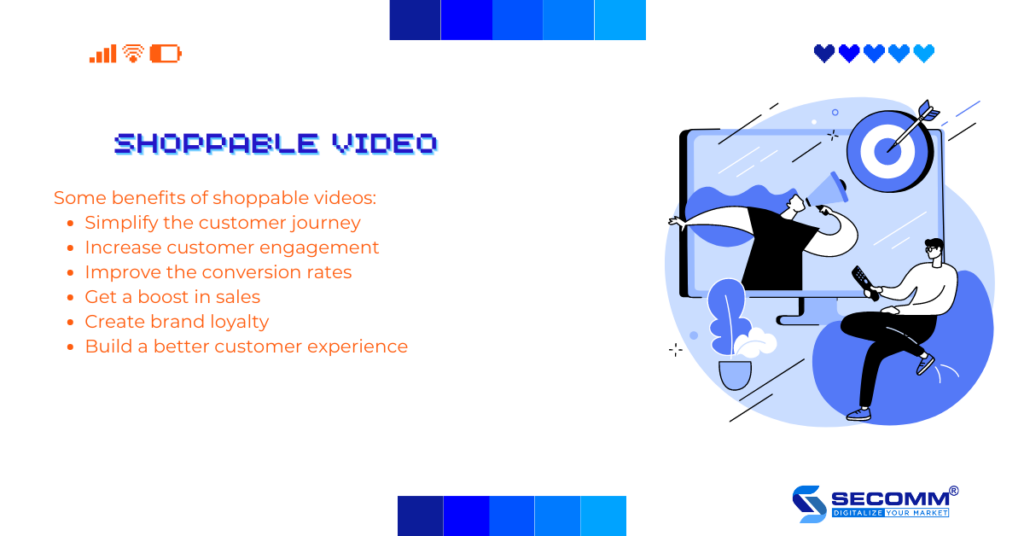
Gamification or Gamification Marketing is the skillful incorporation of a video game’s mechanics into promotional operations in a unique and impressive method to meet marketing objectives.
Gamification’s primary advantage, similar to live selling, is engagement, which keeps people on the site, drives conversions, and boosts sales.
Users are actually more likely to return for more shopping if a business can convince them that engaging with it is an interesting experience rather than a transaction.
A study by Bazaar Voice demonstrates the impact of gamification on businesses’ marketing strategies as follows:
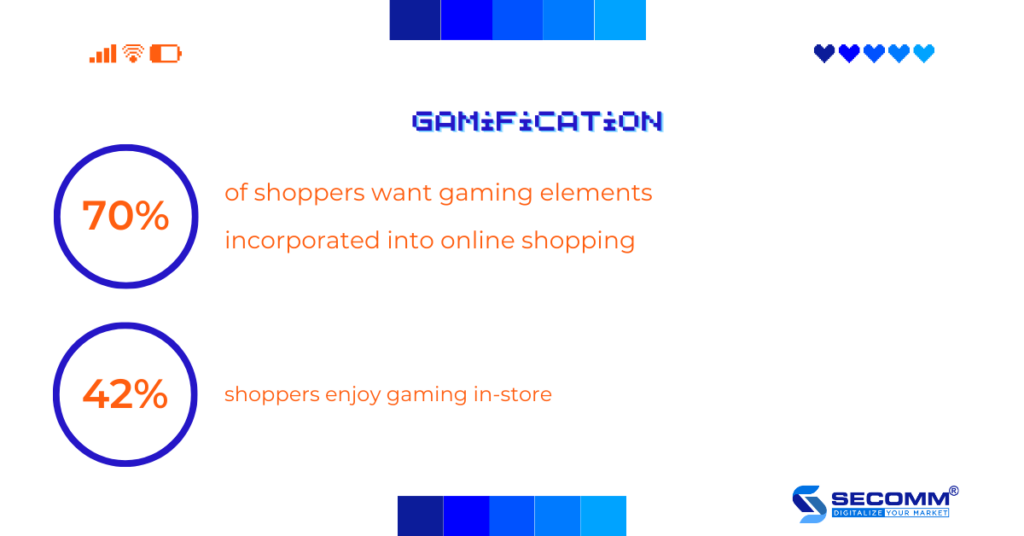
For instance, take Bajaj Finserv’s Indian financial company’s Gamification Marketing campaign. The game was created by this firm to encourage people to use its travel loan services.
Users will complete tasks and respond to questions about their preferred travel destinations. Customers adored the campaign, and it immediately trended on Twitter with more than 75 million impressions.
Thus demonstrating Bajaj Finserv’s efforts to develop engaging experiences and provide them to customers in line with its marketing strategy. Brands attract more potential customers, enjoy the better engagement, and increase conversions as a result of the viral impact.
Shoppertainment has been around for a while, but it wasn’t until Covid-19’s effect that this trend truly took off. Businesses should take advantage of this trend to improve the online shopping experience for customers and increase sales in the era of eCommerce.
Due to the growing demands of customers for a better shopping experience and the ongoing changes in the market, achieving this goal is difficult and labor-intensive. As a result, companies must work with expert agencies to plan the proper eCommerce deployment from the start.
With many years of experience in successfully implementing eCommerce for many customers in many countries, SECOMM specializes in providing consulting services with comprehensive and professional eCommerce implementation solutions.
Contact SECOMM today for free support and advice.
 3
3
 5,933
5,933
 0
0
 1
1Subscribe to get the latest eBook!
Hotline